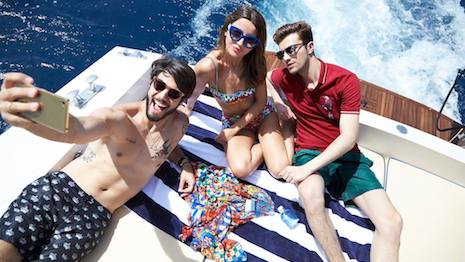This move away from exclusivity is evidenced in influencer marketing, in which brands trust handpicked individuals with desirable social media followings to share their story in their own voice, creating content that appears more authentic than brand posts. A new white paper from Traackr, “Influencer Marketing: 9 Challenges for Luxury Brands,” lays out the key considerations when working with influencers, from selection to content production.
“There has been an enormous shift in the way that the luxury brands have to behave themselves, and what the expectations are in terms what the customers are looking for,” said Minter Dial, founder/president of The Myndset Company and co-author of the report.
“I think the main challenge has been that the luxury brands built on legacy, exclusivity and extraordinarily fine products have seen their model questioned with notions like transparency, real-time and a desire for participation on the part of customers,” he said.
“The challenge for luxury brands is they have preferred to be the ones in control. They have preferred to be the ones, or think of their role as, to set the trends, and especially when it comes to certain creative directors, they’re not particularly interested in the customer’s opinion…
“When it gets into this notion of social media marketing and influencer marketing, it’s a very far cry from, ‘Let’s just do a double page spread in Vogue every month.'”
Under the influence
Within the last couple decades, luxury brands have typically relied on a two-pillar marketing strategy that revolves around selective retail placements and brand differentiation through their Web sites and other digital platforms.
Traackr points out that as purchasing power of those who are not ultra-affluent stalls, brands are becoming more reliant upon their existing client base rather than new customers. This makes it more important for brands to engage with their loyal fans in a meaningful way on a regular basis.
With the rise in ecommerce and digital media consumption, this relationship building has moved from the in-store environment to online channels, particularly social media.
A survey of 300 executives undertaken by The Myndset Company found that those with luxury positioning were more apt to say that digital had “disrupted” their corporate governance than their premium and mass counterparts. Luxury brands also place a greater importance on digital, with about two-thirds of luxury respondents classifying digital “important” or “very important.”
The more exclusive the brand positioning, the greater the portion of marketing budget that goes to digital. More than half of luxury executives designate 30 percent or more of their marketing spend towards digital, compared to 46 for premium labels and even less for mass.
Myndset also found that the most upscale brands are also the most social media active.
Luxury brands, particularly big houses such as Louis Vuitton and Chanel, have amassed large followings on social media. However, creating valuable relationships with an audience that actually turns into a purchase goes beyond more than broadcasting beautiful imagery.
Influencers are skilled at connecting with followers through engaging content that resonates and has an effect on their decision making. If luxury brands create the right strategic relationships with individuals who are a good fit, influencers can be a key asset in digital media.
Key considerations
Traackr cautions that bigger is not always better, and that influencers should be selected for their relevance to the brand, not their follower count. For luxury brands, whose products are not affordable to large swaths of their own social following, picking the right persona to uphold the brand image is more important.
Luxury brands should also not be shy of thinking outside the box for influencer partnerships. While a fashion blogger might be an obvious choice for a label such as Hermès, the brand could instead partner with an influencer who shares an interest. For example, horseback riding and equestrian sports.
Once a brand begins a partnership with an influencer, it should nurture the relationship. This may include giving before asking for anything to earn their trust and treating them as true collaborators rather than mouthpieces.
On a similar note, Traackr cautions against simply “paying for praise,” similar to the model of celebrity endorsements. Not only does this potentially tarnish an influencer’s integrity, but the effect will be buzz more than actual influence.
In lieu of cash, it is suggested that brands grant access to exclusive VIP events, content, factory visits and product loans or testing.
For instance, German label Hugo Boss gave consumers multiple perspectives of its runway show during fall New York Fashion Week in 2015 through partnerships with five popular style bloggers.
Each of the bloggers were gifted a personalized iPhone, which they used to document the show, with their photos and videos appearing on their own channels as well as incorporated in the brand’s livestream microsite. Diversifying the voices that broadcast its runway show gave Hugo Boss the opportunity to reach not only its own audience, but that of the bloggers (see story).
While luxury brands relinquish some control when working with influencers, many shy away from giving them carte blanche. Some brands develop content alongside the influencer to ensure the message fits their positioning, but it is important to also understand the influencer’s perspective and need to have their voice in the posts.
Including influencers in the process can also help brands localize their message. With an increasingly international audience, this is a way for luxury brands to tailor their marketing through a trusted voice.
Luxury brands also need to balance the needs of more traditional clientele who want privacy with the social media generation who want to broadcast everything.
Traackr client de Grisogono leveraged influencer marketing to boost the ROI on its biggest event of the year. After engaging with influencers year-round to find the right fit and build raport, the niche jeweler gave key influencers in the areas of food, art and music access to its Divine party during the Cannes Film Festival.
Influencers campaigns have been found to outperform more traditional marketing initiatives. For certain industries, bloggers have been the driving force in growth.
Fashionbi’s “Top 15 Best Beauty Bloggers to Watch: Makeup & Beauty Vloggers — Evolution, Strategy, Influence and Success Factors” report examines the current state of the personal care market and how beauty video bloggers and makeup professionals have helped brands to embrace the digital potential of beauty marketing. For luxury brands who count professional makeup artists as creative partners, pairing with a well-known beauty vlogger may yield better results, as the Internet celebrity may be more relatable than the artist behind the products (see story).
“It’s interesting how change sometimes is forced on brands and marketers,” said Nicolas Chabot, vice president EMEA at Traackr and co-author of the report. “One of the changes that is forced on them is that their own organic reach is extremely low. So one of the reasons why brands recognize the need to work with engaging individuals is because their own engagement performance is very low.
“Another reason that has been mentioned is, ‘How do I maintain the visibility and credibility of my brand through ad blockers?'” he said.
“One of the big things that is coming and is going to impact that industry next is transparency. When you talk about transparency, it’s interesting to raise the issue of paying influencers, and how is that going to impact that industry and the way that brands will need to engage with those individuals, and how they will bring value to those communities of influencers without having to mention #ad or #sponsored on anything they put out.”
This article first appeared in www.luxurydaily.com





